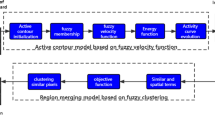Abstract
Solder bump technology has been widely used in electronic packaging. With the development of solder bumps towards higher density and finer pitch, it is more difficult to inspect the defects of solder bumps as they are hidden in the package. A nondestructive method using the transient active thermography has been proposed to inspect the defects of a solder bump, and we aim at developing an intelligent diagnosis system to eliminate the influence of emissivity unevenness and non-uniform heating on defects recognition in active infrared testing. An improved fuzzy c-means (FCM) algorithm based on the entropy weights is investigated in this paper. The captured thermograms are preprocessed to enhance the thermal contrast between the defective and good bumps. Hot spots corresponding to 16 solder bumps are segmented from the thermal images. The statistical features are calculated and selected appropriately to characterize the status of solder bumps in FCM clustering. The missing bump is identified in the FCM result, which is also validated by the principle component analysis. The intelligent diagnosis system using FCM algorithm with the entropy weights is effective for defects recognition in electronic packages.
Similar content being viewed by others
References
Martin P. Electronic Failure Analysis Handbook. New York: McGraw-Hill, 1999. 13, 26–28
Asgari R. Challenges in 3D inspection of micro bumps used in 3D packaging. In: Proceedings of 45th International Symposium on Microelectronics, San Diego, 2012. 542–547
Acciani G, Brunetti G, Fornarelli G. A multiple neural network system to classify solder joints on integrated circuits. Int J Comput Intell Res, 2006; 4: 337–348
Voci F, Eiho S, Sugimoto N. Fuzzy interference filter and morphological operators for short circuits detection in printed circuit board. In: International Symposium on Industrial Electronics, IEEE, 2002. 672–677
Ko K W, Roh Y J, Cho H S, et al. A neural network approach to the inspection of Ball Grid Array solder joints on printed circuit boards. In: International Joint Conference on Neural Network, Como: IEEE, 2000. 233–238
Moore T D, Vanderstraeten D, Forssell P M. Three-dimensional X-ray laminography as a tool for detection and characterization of BGA package defects. IEEE T Compon Pack T, 2002; 25: 224–229
Teramoto A, Murakoshi T, Tsuzaka M, et al. Automated solder inspection technique for BGA-mounted substrates by means of oblique computed tomography. IEEE T Compon Pack T, 2007; 30: 285–292
Su L, Zha Z Y, Lu X N, et al. Using BP network for ultrasonic inspection of flip chip solder joints. Mech Syst Signal Pr, 2013; 34: 183–190
Su L, Shi T L, Lu X N, et al. Defect inspection of flip chip solder bumps using an ultrasonic transducer. Sensors, 2013, 13: 16281–16291
Martin E, Larato C, Ment A C, et al. Detection of delaminations in sub-wavelength thick multi-layered packages from the local temporal coherence of ultrasonic signals. NDT & E Int, 2008; 41: 280–291
Liu S, Erdahl D, Ume I C. A novel approach for flip chip solder joint quality inspection: Laser ultrasound and interferometer system. IEEE T Compon Pack T, 2001; 24: 616–624
Yang J, Ume I C, Zhang L Z. Defect detection of flip chip solder bumps with wavelet analysis of laser ultrasound signals. IEEE T Adv Packaging, 2010; 33: 19–28
Gong J, Ume I C. Nondestructive evaluation of poor-wetted lead-free solder bumps in ball grid array packages using laser ultrasound and interferometric technique. IEEE T Comp Pack Man, 2013, 8: 1301–1308
Wang M H, Chung Y K, Sung W T. Using thermal image matter- element to design a circuit board fault diagnosis system. Expert Syst Appl, 2011; 38: 6164–6169
Lu X N, Liao G L, Zha Z Y, et al. A novel approach for flip chip solder joint inspection based on pulsed phase thermography. NDT & E Int, 2011; 44: 484–489
Lu X N, Shi T L, Han J G, et al. Defects inspection of the solder bumps using self reference technology in active thermography. Infrared Phys Techn, 2014; 63: 97–102
Chuang K S, Tzeng H L, Chen S, et al. Fuzzy c-means clustering with spatial information for image segmentation. Comput Med Imag Grap, 2006; 30: 9–15
Izakian H, Abraham A. Fuzzy c-means and fuzzy swarm for fuzzy clustering problem. Expert Syst Appl, 2011; 38: 1835–1838
Tran V T, Yang B S, Gu F S, et al. Thermal image enhancement using bi-dimensional empirical mode decomposition in combination with relevance vector machine for rotating machinery fault diagnosis. Mech Syst Signal Pr, 2013; 38: 601–614
Author information
Authors and Affiliations
Corresponding author
Rights and permissions
About this article
Cite this article
Lu, X., Shi, T., Wang, S. et al. Intelligent diagnosis of the solder bumps defects using fuzzy C-means algorithm with the weighted coefficients. Sci. China Technol. Sci. 58, 1689–1695 (2015). https://doi.org/10.1007/s11431-015-5896-y
Received:
Accepted:
Published:
Issue Date:
DOI: https://doi.org/10.1007/s11431-015-5896-y




